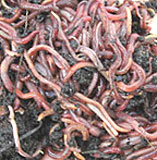Earthworms - A Natural Method of Soil Improvement!
WHAT IS THE WORLD'S LARGEST EARTHWORM?
The world's largest earthworm is thought to be the Giant
Gippsland earthworm, Megascolides Australis.
As the name suggests this worm is native to a small part of southern Australia.
It can grow to a length of more than 3 metres and is 2cm acrosss its diameter.
Australia has around
1,000 native species of earthworm.
LINKS
EARTHWORMS - A GARDENER'S FRIEND
 A familiar sight to gardeners,
earthworms can be seen whenever you dig the garden soil or turn over a
maturing compost.
A familiar sight to gardeners,
earthworms can be seen whenever you dig the garden soil or turn over a
maturing compost.
The earthworm's activities aid plant growth by improving soil structure and fertility.
A LARGE EARTHWORM POPULATION INDICATES GOOD SOIL
A thriving worm population indicates good soil conditions that will also benefit other soil dwellers.
Earthworms are segmented worms, with long tubular bodies marked by a series of lines or rings around the body that indicate the individual segments.
Adult worms have a thickened area, the clitellum or 'saddle', situated about one third of the way down the body from the head end (below left).
HOW DO GARDEN EARTHWORMS MOVE?
Earthworms do not have legs, but move by making use of small
spines or spicules that can be extended from their bodies
Whilst resting most adult earthworms measure 3-12 centimetres in length depending on the particular species, but worms have elastic bodies that stretch considerably and increase in length when they are moving.
HOW MANY SPECIES OF EARTHWORM ARE THERE?
There are about 26 species of earthworms native
to Britain, with another 34 introduced species.
About 16 species of earthworm are commonly found in gardens, occupyingvarious
habitats. Lob worms, Lumbricus
terrestris, are the most frequently of earthworm found in British
gardens
WHERE DO EARTH WORMS LIVE?
Lob worms live in vertical tunnels, which are sometimes several metres deep. The worms pull dead leaves from the surface down into these tunnels. This helps gardeners as helps to this improve the quality of the garden soil for cultivation.
Some types of earthworm such as the Brandling worms and
Compost worms favour rotting vegetation in places such as compost heaps,
where they help and speed up the breakdown process.
Other species of worm, such as the octagonal tailed worms, prefer leaf litter.
WHAT DO GARDEN WORMS EAT?
Many worms eat soil, digesting any organic matter
it contains. These include topsoil
dwellers such as rosy-tipped worms,
Aporrectodea rosea, and the deeper-living
black-headed worms- Aporrectodea longa.
HOW DO WORMS IMPROVE SOIL?
The tunnelling activities of earthworms improve soils by allowing water to drain more freely and air to reach plant roots and soil-dwelling animals.
Earthworms help in breaking down dead plant material, incorporating it into the soil and releasing nutrients that can be absorbed by plant roots.
Many birds, mammals and insects prey on earthworms, making them extremely important in food chains.
Some earthworms produce muddy excrement, known as worm casts, that gradually bury objects on the soil surface - a nuisance on fine lawns but a great help to archaeologists as lost treasures become buried over the ages!
HOW LONG DOES AN EARTHWORM LIVE IN THE GARDEN?
Most earthworms take a year to mature, and live for just one or two years, but individuals have been known to survive for at least eight years.
MORE ARTICLES TO BE FOUND ON GARDEN GROWER
| Get rid of Moss in your Lawn | When to Mulch a Garden | Advice About Growing Grape Hyacinths | Best methods of growing Beetroot | |
An article all about earthworms and how they improve soil and help the gardener.